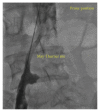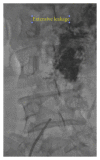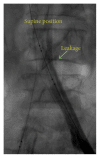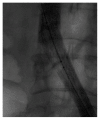Iatrogenic IVC Perforation after Successful Catheter-Directed Thrombolysis
- PMID: 28951796
- PMCID: PMC5603125
- DOI: 10.1155/2017/3746815
Iatrogenic IVC Perforation after Successful Catheter-Directed Thrombolysis
Abstract
Central vein perforation as a rare complication of venous interventions is considered a nightmare if occurring in thoracic cage but behaves benignly in abdominal or pelvic region. This is not a rule, as we unfortunately encountered during the procedure of venous intervention in our patient. Although mechanical control of iatrogenic perforation or rupture is the first and most critical step during interventional procedures, the importance of anticoagulant and thrombolytic agents reversal should not be overlooked.
Figures






References
-
- Braaten J. V., Goss R. A., Francis. C. W. Ultrasound reversibility disaggregates fibrin fibers. Thromb Haemost. 1997;78:1063–1068. - PubMed
Publication types
LinkOut - more resources
Full Text Sources
Other Literature Sources

